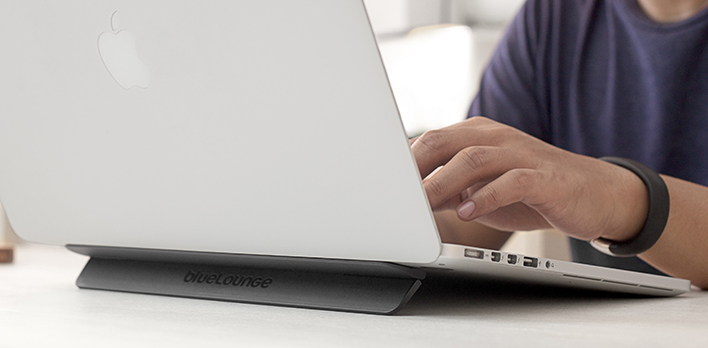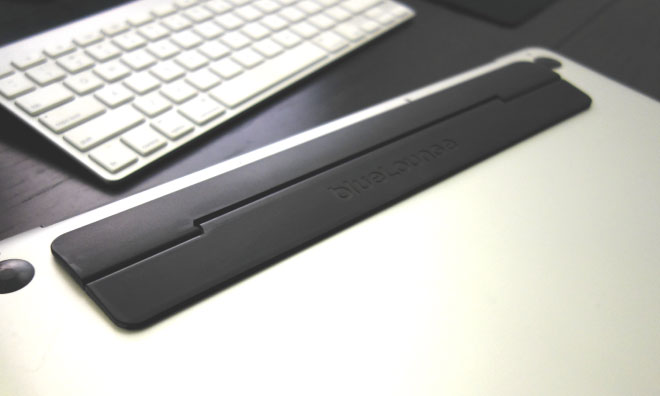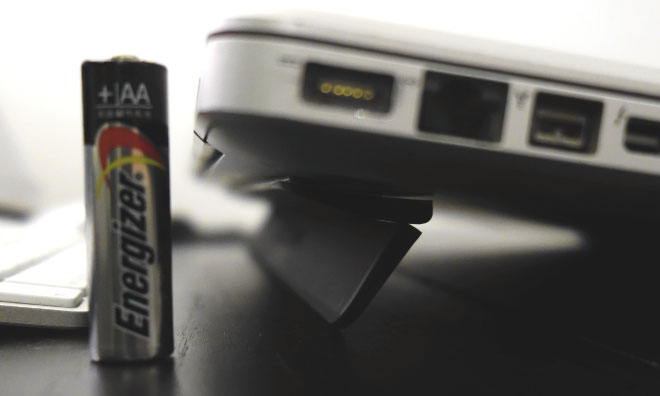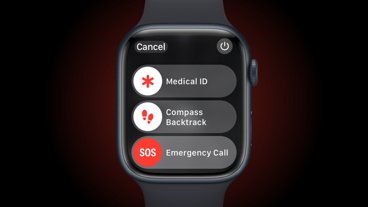For all of the time and effort Jony Ive & Co. have spent crafting their oft-imitated MacBook Pro designs, there is one problem that they've yet to overcome: laptop ergonomics are, by their nature, terrible. AppleInsider took a look at the latest accessory attempting to right this wrong, BlueLounge's new Kickflip stand.
"The design of laptops violates a basic ergonomic requirement for a computer, namely that the keyboard and screen are separated," according to Cornell University's ergonomics reference site. The idea is that neither the keyboard nor the screen should be in a position that causes the user to deviate from their ideal posture, with neck straight and wrists at a neutral position.
With a laptop, this kind of optimization is impossible sans a phalanx of external accessories. Desk-bound laptop users have long employed docking stations, stands, external monitors, and wireless keyboards and mice to give their laptop the same ergonomic benefits as a properly-configured desktop machine.
Laptop users should optimize their environment for typing, rather than reading, if forced to choose.
These accoutrements don't travel well, though. Using a laptop by itself on a coffee shop table or a hotel desk angles the users' arms and forces wrists to a non-neutral position, an ergonomic no-no for typing.
So what are mobile laptop users to do? Faced with the choice of optimizing for neck posture or wrist posture, Cornell recommends that users lean toward the latter —  and that's where BlueLounge's Kickflip can help.
We spent two weeks with the $19.95, 15-inch Kickflip model, using our 2011 MacBook Pro alone on a desk without the usual array of ergonomic accessories. BlueLounge also offers a smaller, $17.95 model that fits the 13-inch MacBook Pro and the MacBook Air.
Design & Installation
The Kickflip is an extremely simple accessory, made of two pieces of plastic — attached at a hinge — and a strip of adhesive. The plastic feels sturdy, with a texture somewhere between soft-touch and a traditional hard finish.
The BlueLounge logo is embossed into the "foot" portion of the Kickflip, and peeks out from underneath the laptop when extended.
Running along the widest part of the Kickflip is a strip of what the company calls "German engineered gel adhesive." This is the only thing that binds the Kickflip to the laptop, and we found it to be plenty strong while maintaining its adhesiveness after repeated repositioning.
Speaking of repositioning, we would've welcomed the inclusion of some kind of guide to help us put the Kickflip on straight. The installation process — Â remove cover strip from adhesive, press onto laptop — isn't exactly difficult, but it is somewhat bothersome.
In Use
Using the Kickflip is even easier than installing it: flip the foot down when you're sitting at a table, flip it back up when you leave. We found the additional angle on the keyboard to be a pleasant addition that made typing much easier, as it allowed our wrists to stay at a nearly-neutral angle.
As a bonus, the incline also helped lessen the sting of the sharp metal edges on the MacBook Pro's wrist rests.
The Kickflip also adds a nearly-imperceptible amount of lift when closed, just enough to raise the MacBook's rear feet off of the surface. That brings up our biggest gripe with the Kickflip: the lack of grip.
We like the Kickflip if for no other reason than that it helps alleviate the MacBook Pro's sharp edges.
The Kickflip's foot makes contact with the table surface along its edge. The tiny strip of hard plastic doesn't offer much purchase, and we occasionally found ourselves accidentally pushing the laptop away when typing or using the trackpad.
On the natural wood desk we use in our home office, the problem is almost nonexistent. The slick melamine surface of the shared tables in our coworking space, however, exacerbated the issue and forced us to use a small piece of non-slip mat underneath — the kind usually used in the cabinets of boat galleys.
We also don't like the way the foot "flops" out away from the laptop when closed, which occasionally cause it to snag when sliding it out of our bag. Even at the cost of complexity and additional dollars, we would've preferred that the foot be sprung to keep it more secure when stowed.
Conclusion
Subjectively, we feel noticeably less wrist fatigue when using the Kickflip than when we keep the laptop directly on our desk. Of course, the same effect could be had simply by propping up the back of our laptop on a book, but that's not the most stable nor portable arrangement.
On balance, the Kickflip is a useful accessory that falls down just slightly thanks to a couple of questionable design decisions. The ergonomic benefits outweigh our minor grumbles, though, and we feel comfortable recommending the Kickflip without reservation for anyone who is often forced to use their laptop by itself on a desk.
Score: 3.5 out of 5
Pros
- Greatly improves typing ergonomics
- When closed, gives a welcome extra handhold to carry your laptop
- Relatively inexpensive as Apple accessories go
Cons
- Reduces grip on tabletops, sometimes causing the laptop to slide when typing
- Foot doesn't close solidly, causing some hangups when going in and out of bags
Where to buy
The BlueLounge Kickflip is available in 13-inch and 15-inch models directly from BlueLounge or via retailers like Amazon.
 Sam Oliver
Sam Oliver





-m.jpg)






 William Gallagher
William Gallagher

 Andrew O'Hara
Andrew O'Hara
 Wesley Hilliard
Wesley Hilliard

 Malcolm Owen
Malcolm Owen
 Marko Zivkovic
Marko Zivkovic





-m.jpg)




13 Comments
Since ergonomic keyboards sometimes tilt AWAY from the user, I've assumed that's the best angle (as long as a wrist rest is involved). So I never understood why it's good to make a flat keyboard tilt the wrong way, towards you (making the laptop wrist rest less useful in the process). I know many of us have habits from typewriter-inspired tilted desktop keyboards, but is it truly ergonomic to prolong that habit? I can see people might WANT their laptop to match their desktop's tilt. But "ergonomic?" What IS the best angle, ergonomically? (I know a split is good too.)
Are you sure the "improvement" in typing ergonomics isn't placebo effect? Tilting a keyboard up in the back is not an ergonomic improvement. Let your arms hang at your sides, relax, and note the position of your hands. To maintain that same rested position while typing, the front of the keyboard should be a little higher than the rear, opposite "conventional wisdom". Look at Microsoft's "Natural Ergonomic Keyboard" which comes with a lift for the front of the keyboard. Even without the lift, the number key row is even, or a bit lower than the space bar. http://www.amazon.com/Microsoft-Natural-Ergonomic-Keyboard-4000/dp/B000A6PPOK Fifteen years ago, I suffered both carpal and radial tunnel syndrome. It got much worse after the occupational therapist rearranged my workspace, so I spend some time experimenting. Tilting the keyboard opposite her recommendations finally offered relief. Of course my situation is anecdotal, but I think you'll find that the conventional wisdom in ergonomics has been wrong and is changing. ETA: I should add that keyboards are often used at the wrong height with respect to the elbows. Your forearms should be approximately level, maybe even sloping slightly down (the idea is to get your body in a restful position). If they're tilting up to reach the keyboard (often the case), then a flat keyboard (as in a laptop) may effectively have the right tilt with respect to the forearms.
The best solution depends on the individual, but in general, tilting the keyboard up at the back increases stress on the carpal tunnel. So one might expect this product to cause or exacerbate that condition. Splitting the keyboard and raising the center at the G-H split brings the hand's pronation more into alignment with the rest position. That's clearly not an option for a laptop, but flat layout of laptop keys is better than most desktop keyboards, which tilt the wrong way.
And often any change in ergonomics brings short term relief. A change is as good as a rest.
The original typewriters had to arrange the keys in an upward slope to allow the mechanisms to have room to actuate the levers. As typewriters developed, they flattened out the keyboard somewhat to make it more ergonomic. Just because it is traditional to have a tilted keyboard does not make it ergonomic. The wrist naturally is more comfortable in a flat or downward position and it is a strain to have our wrists bent upwards. Before people make these ridiculous claims that 'this is better,' they should do studies on things like the causes of carpal tunnel syndrome and human anatomy.
I am not a fan of laptops. I can appreciate that there are people who absolutely have to use them, but I refuse to. Instead, I have a desktop at home (iMac) desktop at work (Mac Pro) and when I'm mobile I use a combination of my iPhone and iPad, and I only use them for activities that do not require a bunch of typing. I guess I'm fortunate that I can structure my work and life so that this is feasible for me. My sympathy to people who cannot.